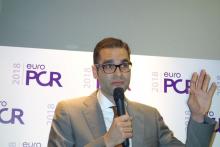PARIS – Endovascular device–delivered renal denervation has been dramatically resuscitated as a promisingly safe and effective nonpharmacologic treatment for hypertension on the basis of two rigorous positive, prospective, sham-controlled, randomized trials presented at the annual meeting of the European Association of Percutaneous Cardiovascular Interventions.
“These two trials are proof of concept. They were not intended to show superiority of denervation over drug therapy. They provide the proof of principle that when we interfere with the renal sympathetic nervous system we are able to lower blood pressure,” according to Felix Mahfoud, MD, an interventional cardiologist at Saarland University Hospital in Homburg, Germany, who was a coinvestigator in both trials.
As a longtime investigator in the field, he was selected by the EuroPCR 2018 organizers to present an official statement to attendees in conjunction with presentation of the two late-breaking clinical trials. The essence of the official commentary was that, despite what physicians have heard based on earlier major setbacks, renal denervation (RDN) therapy for hypertension is alive and well; it’s an active area of investigation; and it holds promise for addressing the vast unmet need for better control of hypertension.
“It’s an interesting field. EuroPCR is committed to further support of the field. Stay tuned; there’s more to come. It’s been a bumpy road up until now, but I think we’re back on track with renal denervation,” Dr. Mahfoud said.
A few years ago RDN was widely dismissed as a failed treatment strategy on the basis of the negative results of the phase 3 SYMPLICITY HTN-3 trial conducted in patients with multidrug-resistant hypertension (N Engl J Med. 2014 Apr 10;370[15]:1393-401). Since then, two European consensus conferences on device-based hypertension therapies were held in 2015 and 2017. Those meetings analyzed key mistakes in earlier research and identified three key confounders that need to be standardized in order for high-quality research to move forward: The use of antihypertensive medications, or lack thereof, must be fixed and consistent; patients with severe treatment-resistant hypertension for whom basically nothing works are not the population to study initially; and key trial design and procedural details for the various endovascular therapies in development must be agreed upon.
The two sham-controlled trials presented at EuroPCR 2018 utilized different ablative energy sources: The RADIANCE-HTN SOLO study employed an ultrasound catheter, while the SPYRAL HTN-ON MED trial used a radiofrequency device. Both devices remain investigational. Each aims to ablate both the afferent and efferent renal sympathetic nerves located in the adventitia that run to and from the brain.
RADIANCE-HTN SOLO
Laura Mauri, MD, professor of medicine at Harvard Medical School, Boston, reported on 146 patients with mild to moderate hypertension at 39 U.S. and European centers, all of whom were deemed anatomically suitable for device therapy on the basis of the results of renal angiography. After a 4-week antihypertensive medication washout period, by which point their average blood pressure had climbed to 150/93 mm Hg, they were randomized in single-blind fashion to endovascular ultrasound RDN using ReCor Medical’s Paradise system or to renal angiography as a sham procedure.

